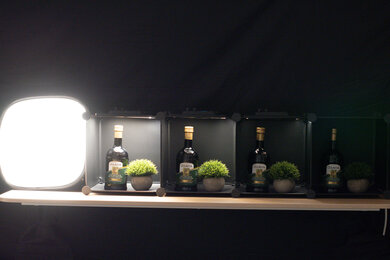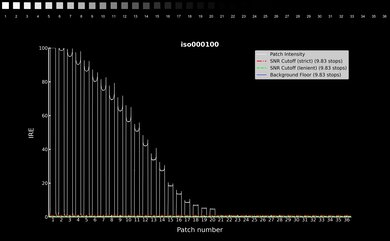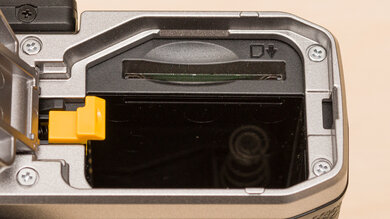The Nikon Z fc is a digital APS-C camera designed to look like the vintage Nikon FM2 SLR. Though it looks like an old-fashioned SLR on the outside, complete with silver accents and a squared-off body, the Z fc is a modern interchangeable-lens mirrorless camera with similar internals and the same 20.9-megapixel APS-C sensor as the Nikon Z 50. Unlike the Z 50, however, it has a fully articulated touchscreen and, true to its vintage-inspired design, includes dedicated shutter speed and ISO dials that make it easy to adjust settings on the fly.
Our Verdict
The Nikon Z fc is good for travel photography. It's lightweight and easy to travel with, though it lacks a handgrip and isn't the most comfortable to use for long periods. Its overall image quality is excellent, with very solid low-light performance for an APS-C sensor. It also has a good autofocus system and quick burst shooting for faster subjects. However, its battery life isn't amazing, though battery performance can vary drastically with real-world conditions.
-
Excellent image quality.
-
Great autofocus.
-
Fairly portable.
-
No handgrip.
-
Mediocre battery life.
The Nikon Z fc is great for landscape photography. It delivers excellent overall image quality and performs quite well in low light for an APS-C sensor. It also has excellent dynamic range to bring out more highlight and shadow detail in high-contrast landscapes. That said, it isn't the most comfortable camera to use since it lacks a handgrip, and it isn't weather-sealed to protect against moisture or dust.
-
Excellent image quality.
-
Great autofocus.
-
Fairly wide dynamic range.
-
No handgrip.
-
Not weather-sealed.
The Nikon Z fc is good for sports and wildlife photography. It has a quick max burst rate and a decent-sized buffer, though it takes a bit of time to empty once full, which can slow you down at a critical moment. On the upside, its autofocus system tracks moving subjects quite well, and image quality is excellent overall. That said, it isn't the most comfortable camera to use since it lacks a handgrip. Its battery life isn't great, either.
-
Very fast continuous shooting speed.
-
Excellent image quality.
-
Great autofocus.
-
No handgrip.
-
Mediocre battery life.
The Nikon Z fc is great for vlogging. It has a fully articulated touchscreen, so you can monitor yourself while recording. It also automatically switches into 'Self-Portrait' mode when you flip its screen around, making it easier to make exposure adjustments when recording yourself. Its autofocus system does an amazing job of tracking faces, ensuring you always stay in focus. It delivers good overall video quality in brighter conditions, though it's worse in low light, and there's some noticeable rolling shutter effect in 4k. There's also no in-body image stabilization for smoother handheld shooting.
-
Fantastic autofocus tracking.
-
'Self-Portrait' mode.
-
Fully articulated screen.
-
Stabilization is only decent with kit lens.
-
Significant rolling shutter effect in 4k.
The Nikon Z fc is okay for studio video, though this isn't its main intended use. It has decent internal recording capability and an easy-to-use menu system. While it has a microphone jack and Micro HDMI port, it lacks a headphone jack and doesn't come with a USB cable in the box. Its overall video quality is good in more controlled lighting conditions, though it doesn't have any Log recording option to capture more dynamic range, and it performs worse in low light. There's also significant rolling shutter effect in 4k when panning the camera. On the upside, it has a fantastic autofocus system for video.
-
Fantastic autofocus tracking.
-
Good internal recording capability.
-
Several inputs and outputs.
-
Significant rolling shutter effect in 4k.
-
No headphone jack.
The Nikon Z fc is a poor choice for POV-style action video. It isn't designed to mount to a helmet or chest rig, and it isn't waterproof or water-resistant. Overall, video quality is great in brighter lighting conditions, though there's noticeable rolling shutter effect in 4k. High frame rate options are also limited in 4k, though it does have recording up to 120 fps in 1080p.
-
Fantastic autofocus tracking.
-
Can record at up to 120 fps in FHD.
-
Can't mount on helmets or action cam rigs.
-
Significant rolling shutter effect in 4k.
-
Stabilization is just okay in 4k.
The Nikon Z fc has great RAW photo performance. Its dynamic range is excellent, so it preserves a wide range of shadows and highlights. Though the camera doesn't have the highest-resolution sensor among its peers, images still look quite sharp and detailed. Noise handling is good, too, so it performs quite well in low light.
-
Fairly wide dynamic range.
-
Good noise performance in low light.
-
Slightly lower resolution than most peers.
- 7.7 Travel Photography
- 8.0 Landscape Photography
- 7.8 Sport & Wildlife Photography
- 8.1 Vlogging
- 7.9 Studio Video
- 4.7 Action Video
Performance Usages
- 8.1 Raw Photo
Changelog
-
Updated Feb 25, 2025:
We updated the Differences Between Sizes and Variants section to include new color variants available for this camera.
-
Updated Feb 11, 2025:
We wrote text for the new tests added in Test Bench 0.13 and updated the Verdict section accordingly.
- Updated Feb 03, 2025: We've converted this review to Test Bench 0.13. We've added new tests for Video Dynamic Range and Luminosity Patch Detection. You can learn more about these updates in the changelog.
- Updated Jan 29, 2024: Added text to the 'Raw Photo Performance' verdict box.
- Updated Jan 29, 2024: Converted to Test Bench 0.12.1.
Check Price
Differences Between Sizes And Variants
The Nikon Z fc comes in a handful of colors: Black, Silver, Chalk Blue, and Crimson Red. We purchased the Silver version; here's a picture of our unit's label.
You can buy the camera body on its own or bundled with a Nikkor Z DX 16-50mm f/3.5-6.3 VR kit lens.
Let us know if you come across a different variant or if your Nikon Z fc doesn't correspond to our review, and we'll update it.
Compared To Other Cameras
Taking inspiration from the past, the Nikon Z fc stands out among entry-level cameras for its retro design. While its ergonomics and physical control dials may not be for everyone, the camera undoubtedly looks great. Internally, it performs much like the Nikon Z 50, with plenty of great features and performance for various kinds of photography and less advanced video work. That said, its battery life isn't great, and it doesn't have the sturdiest build quality among entry-level cameras.
For more options, check out our picks for the best mirrorless cameras for beginners, the best cameras for street photography, and the best cameras for vlogging.
The Nikon Z fc and the Nikon Z 50 perform very similarly overall. They use the same 20 MP sensor, so image and video quality is comparable. However, the Z fc has slightly more consistent AF tracking performance. That said, the biggest difference between the two is design. The Z fc is designed to look like a vintage SLR, with more dedicated control dials, and has a fully articulated screen that makes it a little better-suited to vlogging. The Z 50, on the other hand, is a little less portable but feels more comfortable in the hand thanks to its handgrip. Unlike the Z fc, it has a tilting screen that's better suited to waist-level photography.
The Sony α6400 and the Nikon Z fc are both great entry-level APS-C cameras. That said, the Sony is a little more portable, feels a bit better built, and is more comfortable to shoot with. It also has a slightly more effective autofocus system and a better battery life. On the other hand, the Nikon has slightly better noise handling and dynamic range, along with a fully articulated screen that's better suited to vlogging and video work.
The Nikon Z fc and the Fujifilm X-T30 II perform similarly overall, with a few key differences. The Fujifilm is more portable and has a tilting screen that's great for waist-level shooting. It uses a higher-resolution sensor than the Nikon, but the Nikon is a bit better when it comes to dynamic range and low-light noise handling. The Nikon is bigger and has a fully articulated screen that's better for video and vlogging. It also has a more reliable autofocus tracking system.
The Nikon Z fc and the Fujifilm X100V both take some design inspiration from old-school film cameras. However, they're quite different cameras. The Fujifilm is a compact camera with a fixed prime lens, while the Nikon is an interchangeable-lens camera. If you want something more portable, the Fujifilm is the way to go. But if you're looking for the versatility to be able to switch out different lenses, get the Nikon.
Test Results
The Nikon Z fc is fairly portable. Its slim, old-school design doesn't feature a handgrip, which makes it more portable at the expense of ergonomics. It's a lightweight camera, too. If you're looking for something even more portable, consider the OM SYSTEM OM-5.
Build quality is good overall, though parts of it definitely feel cheaper than its retro exterior makes it appear. Unlike a vintage SLR, the Z fc has a plastic exterior that doesn't feel especially sturdy. However, internally, it has a magnesium alloy frame. The dials are also aluminum, but the buttons can feel somewhat slack, and the battery and SD card cover feels very flimsy.
The ergonomics are okay. It's really easy to adjust settings thanks to the camera's dedicated ISO and shutter speed dials. You also have additional command dials on the front and back, with plenty of customization options to set the controls exactly as you like. That said, the squared-off body lacks a handgrip, so it isn't the most comfortable camera to hold.
The EVF has a fairly typical 2.36 million dot resolution, which gives you a pretty clear view through the viewfinder. It doesn't have the most comfortable eyecup, but it's still fairly comfortable to use.
The Nikon Z fc has a fully articulated screen that's great for vlogs or shooting at different angles. All in all, the screen mechanism feels sturdy. It also has a pretty high resolution, so the image looks crisp on the monitor. If you'd prefer a camera that has a tilting screen with a higher resolution, check out the Fujifilm X-T30 II.
By default, the Z fc goes into 'Self-Portrait' mode when you flip the screen around to face forward. This mode automatically sets a three-second timer for photos and videos and shows fewer on-screen options. You can also change shutter speed, aperture, and ISO via the touchscreen in this mode. However, it prevents you from accessing the menu, quick menu, or playback function.
Menu is easy to navigate using the touchscreen or physical controls. Some functions are harder to find, but once you get familiar with the menu, it's easy to find what you need. The menu also remembers the last option you visit, making it easy to jump back into whatever setting you were modifying. The 'i' menu lets you access frequently used settings, and you can customize it to include your preferred settings. There's also a help/guide function to help new users understand certain settings and features.
If you want a similar camera with a full-frame sensor, check out the Nikon Z f.
Battery life is decent. It's on par with the Nikon Z 50, with a 300-photo CIPA rating. That isn't amazing, even among mirrorless cameras, especially compared to competitors like the Sony a6400 or the Fujifilm X-E4. Still, depending on how you use it, you can still get a fair amount of shots on a full charge. The Z fc also supports USB charging, though it doesn't come with a USB cable in the box.
In video, the camera lasts a decently long time, with about an hour and a half of continuous video recording when using its highest quality settings.
The Nikon Z fc can shoot at a fairly quick max burst rate, which is great for capturing bursts of quick movement. It performs very similarly to the Nikon Z 50 in this respect, with the exact same buffer depth. Its capacity is decent, but you'll fill it up quite quickly when shooting in RAW. If you do fill the buffer, it takes almost 10 seconds to empty, which isn't bad but can slow you down or cause you to miss a critical moment.
The Nikon Z fc has a very solid autofocus system. It supports both face and eye detection, as well as animal detection for pets like cats and dogs. As far as tracking goes, it doesn't quite reach the heights of Sony's Real-Time AF Tracking, even on APS-C models like the Sony a6400. However, the Nikon's tracking feature still does a good overall job of keeping moving subjects in focus. For the most part, it stays with subjects even when they're moving quickly, though it can still sometimes lose track with more erratic movements. All in all, it has a solid hit rate.
If you don't want to rely on tracking, the autofocus is very effective. When using the center point, the camera can stay with moving subjects very well. You may still get a few soft or out of focus shots here and there, but overall it's very reliable.
That said, we did notice during a few runs that the camera would occasionally take an extra second or two after pressing down the shutter button before actuating the shutter. It's possible this is because we shot this test using 'Focus Priority', but the delay occurred even when the camera had indicated that focus was achieved while half-pressing.
The Nikon Z fc doesn't have in-body image stabilization, but you can still pair it with optically stabilized lenses. With the Nikkor Z DX 16-50mm f/3.5-6.3 VR lens, it does a great job of reducing camera shake and allowing you to get clear shots at slow shutter speeds. That said, stabilization performance can vary depending not only on the lens, but also things like focal length and how steady your hands are.
Dynamic range is excellent. It performs similarly overall to the Nikon Z 50. Naturally, you lose some dynamic range in low light, but overall, the camera can capture a wide range of highlight and shadow detail, especially relative to other APS-C cameras.
The Z fc does a great job of resolving fine detail and gives you some leeway to crop your photos. This is mostly noticeable when zooming in or cropping heavily.
RAW noise handling is good overall. Images hold up slightly better at higher ISOs in low light than competitors like the Sony a6400 when it comes to noise. It's on par with the Nikon Z 50 and is pretty well-suited to low-light photography for an APS-C sensor.
Unlike the Nikon Z 50, there's no crop when shooting in 4k. It can record 4k video at up to 30 fps, but there are no high frame rate options for slow-motion recording in 4k.
4k internal recording capability is pretty good. It's limited to 8-bit 4:2:0 recording, but it doesn't support Log profiles, so you wouldn't really be able to take advantage of 10-bit color anyway. On the upside, the camera has excellent heat management, with no overheating throughout extended recording sessions. However, there's still a half-hour time limit on recording.
Autofocus is amazing in 4k. It's incredibly effective at tracking moving subjects within the frame. Unlike the Nikon Z 50, the Z fc supports eye detection in video mode for more precise tracking.
Video quality is great in more controlled lighting conditions. It's sharp and detailed, and the colors straight out of the camera pop nicely. However, it's just okay in low light, with some heavy noise and trouble pulling out detail in the shadows.
There's a bit less rolling shutter effect than on the Nikon Z 50. However, it's still quite noticeable, especially with very quick camera movements and panning shots.
In FHD, the camera can record at up to 120 fps without a crop. There's a dedicated slow-motion recording mode, as well, which automatically slows down and plays back your footage at 30 fps for up to 4x slow motion.
Internal recording capability is good in 1080p, though it's limited to 8-bit, just as it is in 4k. There's still a half-hour cap on recording as well, but it can capture 1080p video at very high bit rates for higher quality.
Autofocus is still excellent in 1080p, although not quite as consistent. The focus transitions can be a bit slow but feel very smooth. All in all, it's very effective at tracking and keeping moving subjects in focus when recording videos.
Rolling shutter effect is a lot less noticeable in 1080p. There's still some slanting vertical lines with very quick camera pans, but overall, it shouldn't be overly distracting.
The Nikon Z fc doesn't support Log recording, so its total dynamic range is limited. You won't have as much flexibility in post to push your exposure one way or the other without losing detail. For more flexibility and wider dynamic range, you'll have to step up to a higher-end model like the full-frame Nikon Z f.
Tested Settings:
- Resolution: 4k
- Frame Rate: 30 fps
- Log Format: N/A
While the Z fc doesn't have a headphone jack, it has a stereo mic input, along with a Micro HDMI (Type D) port. You'll need an adapter to connect an external display, but connectivity options are pretty good overall.
Comments
Nikon Z fc: Main Discussion
Let us know why you want us to review the product here, or encourage others to vote for this product.
This product has been merged with Nikon Z fc DX-Format Mirrorless Camera with NIKKOR. Follow the discussion here.

































































